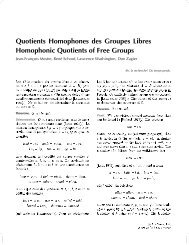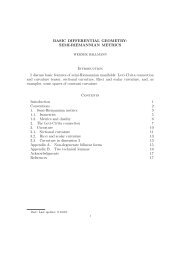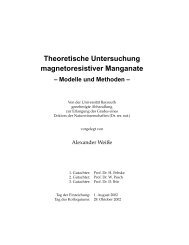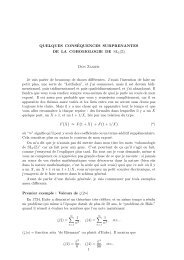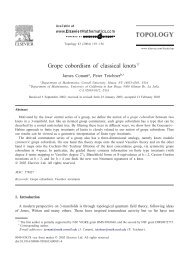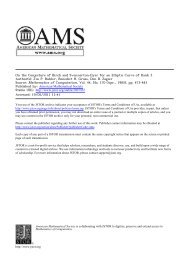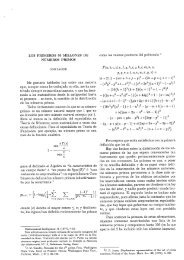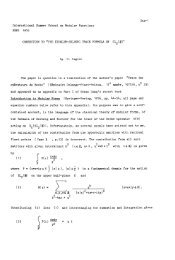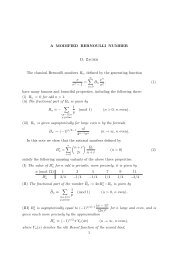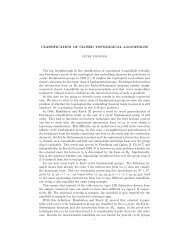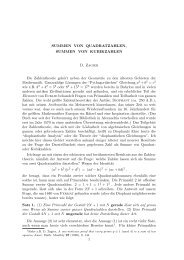Elliptic Modular Forms and Their Applications - Up To
Elliptic Modular Forms and Their Applications - Up To
Elliptic Modular Forms and Their Applications - Up To
Create successful ePaper yourself
Turn your PDF publications into a flip-book with our unique Google optimized e-Paper software.
26 D. ZagierThe point is now that the two transformations z ↦→ z +1<strong>and</strong> z ↦→ −1/4zgenerate a subgroup of SL(2, R) which is commensurable with SL(2, Z), so(30) implies that the function θ(z) is a modular form of weight 1/2. (Wehave not defined modular forms of half-integral weight <strong>and</strong> will not discusstheir theory in these notes, but the reader can simply interpret this statementas saying that θ(z) 2 is a modular form of weight 1.) More specifically, forevery N ∈ N we have the “congruence subgroup” Γ 0 (N) ⊆ Γ 1 = SL(2, Z),consisting of matrices ( abcd)∈ Γ1 with c divisible by N, <strong>and</strong> the larger groupΓ 0 + (N) = 〈Γ (0(N),W N 〉 = Γ 0 (N) ∪ Γ 0 (N)W N ,whereW N = √ 1 0 −1)N N 0(“Fricke involution”) is an element of SL(2, R) of order 2 which normalizesΓ 0 (N). The group Γ 0 + (N) contains the elements T = ( 1101)<strong>and</strong> WN for anyN. In general they generate a subgroup of infinite index, so that to check themodularity of a given function it does not suffice to verify its behavior justfor z ↦→ z +1 <strong>and</strong> z ↦→ −1/N z, but for N =4(like for N =1!) they generatethe full group <strong>and</strong> this is sufficient. The proof is simple. Since WN 2 = −1, itissufficient to show that the two matrices T <strong>and</strong> ˜T = W 4 TW4 −1 = ( 1041)generatethe image of Γ 0 (4) in PSL(2, R), i.e., that any element γ = ( abcd)∈ Γ0 (4) is,up to sign, a word in T <strong>and</strong> ˜T .Nowa is odd, so |a| ≠2|b|. If|a| < 2|b|, theneither b+a or b−a is smaller than b in absolute value, so replacing γ by γ ·T ±1decreases a 2 + b 2 .If|a| > 2|b| ≠0, then either a +4b or a − 4b is smaller thana in absolute value, so replacing γ by γ · ˜T ±1 decreases a 2 + b 2 .Thuswecankeep multiplying γ on the right by powers of T <strong>and</strong> ˜T until b =0,atwhichpoint ±γ is a power of ˜T .Now, by the principle “a finite number of q-coefficients suffice” formulatedat the end of Section 1, the mere fact that θ(z) is a modular form isalready enough to let one prove non-trivial identities. (We enunciated theprinciple only in the case of forms of integral weight, but even without knowingthe details of the theory it is clear that it then also applies to halfintegralweight, since a space of modular forms of half-integral weight canbe mapped injectively into a space of modular forms of the next higher integralweight by multiplying by θ(z).) And indeed, with almost no effort weobtain proofs of two of the most famous results of number theory of the17th <strong>and</strong> 18th centuries, the theorems of Fermat <strong>and</strong> Lagrange about sums ofsquares.♠ Sums of Two <strong>and</strong> Four SquaresLet r 2 (n) = # { (a, b) ∈ Z 2 | a 2 + b 2 = n } be the number of representationsof an integer n ≥ 0 as a sum of two squares. Since θ(z) 2 =(∑a∈Z qa2 )(∑b∈Z qb2 ),weseethatr2 (n) is simply the coefficient of q n inθ(z) 2 . From Proposition 9 <strong>and</strong> the just-proved fact that Γ 0 (4) is generated by−Id 2 , T <strong>and</strong> ˜T , we find that the function θ(z) 2 is a “modular form of weight 1<strong>and</strong> character χ −4 on Γ 0 (4)” in the sense explained in the paragraph precedingequation (15), where χ −4 is the Dirichlet character modulo 4 defined by (15).



